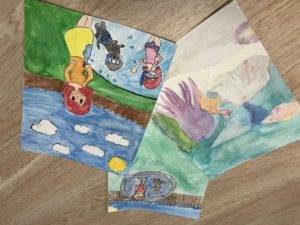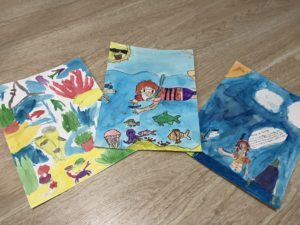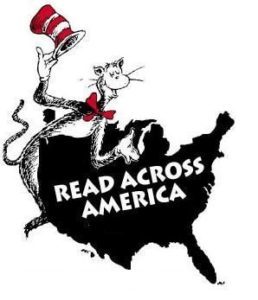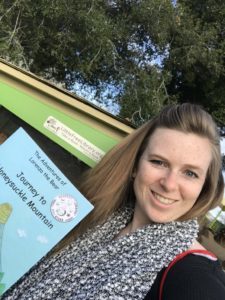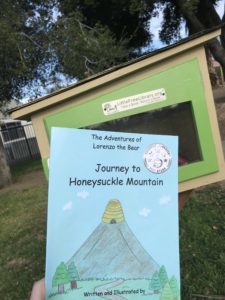Carmela Dutra's Blog, page 3
April 18, 2018
Author Workshops and Visits, what’s it all about?
Since the end of February start of March, I have been keeping pretty busy with school events. First, was Read Across America Week. Then I had a Family STEAM Night at Rosemary Elementary. Next, I have another school event at CMS.
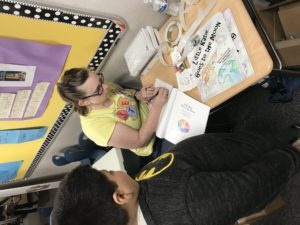
Signing copies of Little Katie Goes to the Moon
After these have finished up, I have a return Pearl Zanker, and then potentially a new school district to work with in my area. I’m super excited about the possibility to work with a new group of students. Don’t get me wrong. I love watching the students grow in knowledge over the years, and being able to have a share in this is exceptionally rewarding.
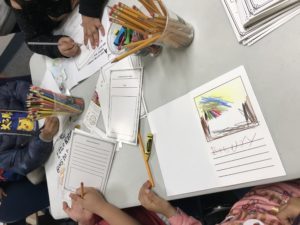
Writing their own narrative stories
What have these visits taught me? It’s more just a visit. These workshops help reach the children on a different level. Sparking something inside them that otherwise might not have been awoken. It’s also a great way to help parents have an active role with their kids.
One of the districts has a strong focus on parent and community involvement. I work closely with the lead for parent and community involvement representative from the district office. We spent countless hours customizing a specific educational plan to use at the schools that would help encourage parent involvement. I will say, I am unsure who enjoyed the visits more. The children, or their parents!
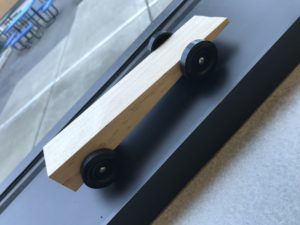
Wooden Wedge Car
The photos you have been seeing are from my most recent school visits. I worked with the students on story development and David taught them design and engineering through constructing derby cars. What is so great about an author visit?
Besides being a fun break from the classroom routine, an author or illustrator visit introduces students to the processes of writing, developing characters, and expressing one’s creativity. It gets readers excited about books, and it provides an opportunity to encourage young writers.
The teachers have genuinely valued these visits as well and took an active role in participating. Here are what some have said.
“The teachers sang Ms. Dutra’s praises all week. All I heard was how much the staff, students, and parents loved her visits. I had several teachers request for her to visit again. I hope she returns; she is welcome at my school anytime.” Mr.Schmaedick, Principal
“Having Ms. Dutra in the classroom was such inspiration for my students! Not only was she patient and understanding, but she was very flexible and accommodating. She worked closely with each one of my students. After her visit, my students were encouraged to do more in the area of creative writing. They were so excited to start their next writing assignment in class. We need more visits like these! We need professionals to visit our students so they can see that they can grow up to be more than just a doctor, firefighter, or a policeman.” Ms. Valiani, first grade.
“It was wonderful having a STEAM author visit our school. For the students to meet someone who started off just like them and went on to write and produce children’s literature is quite the amazing privilege. Carmy really went out of her way to include everyone, to encourage parents to have a share, and make the whole experience fun.” Ms. Darchuck, second grade.
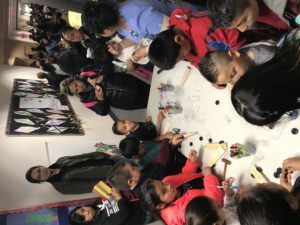
Constructing and designing wooden wedge cars
I believe firmly in giving back to the schools and take my role seriously to help plant these seeds of interest with them. That is why even if a school is not local, or has had funding cut, I always do everything in my power to work with them in some way I can. Click the link below, to learn more about school visits, and how you can benefit from one.
http://carmeladutra.com/about/author-...
Have you had the privilege of either hosting or attending an author school visit? Share your comments or questions below! Thanks for stopping by!
March 21, 2018
Thank You!
Hi everyone,
I want to thank all of you for joining me each as I share my random thoughts you. Everything from my journey through parenthood, and author school, and everything else in between.
Your tuning in each week keeps me going and blogging away. I just wanted to let you know I appreciate your time. Time is the one thing all of us have equal amounts of, yet, it’s so precious, and we are often struggling to find extra time. So the fact that each week you give of your valuable time and share it with me, that just means the world to me.
From me to all of you,
THANK YOU!!
March 7, 2018
How to inspire creativity in children
Being a mother is the highlight of my life. I’m always thinking of ways to help my little guy, for his mind grow and help him explore the world around him. Being an author who works with young children regularly, I think about his same thing too. How can I reach these kids? What can I do to inspire them?
You probably already know how important it is for kids to indulge their creative side, but even when they’re up for being imaginative, many projects are mostly a lesson in following instructions. That’s certainly valuable, but real creativity also involves figuring things out for themselves.
This is something I’ve learned throughout the years of working in classrooms. When collaborating with a class on a project, I give the students parameters but ultimately giving them free reign to complete the task. Most recently, I worked with a fifth grade class on illustrations for an upcoming children’s book I have set to be released next month.
The class was broken up into teams of two or three students and assigned a page to illustrate. I told them roughly what I was looking for, and said the rest was up to them. I encouraged them to brainstorm together, and reminded them they are only limited by their imagination, so set it free and get creative.
This project-based, interactive experience inspires kids like nothing I’ve ever seen.
Read on for tips on how to inspire your children, and see how I implemented these same tips when working in the classroom.
Practice what you preach.
Mentor and coach alongside your children, It’s incredibly inspiring for kids to work with their parents, instead of merely taking directions from them. I always work alongside the students on the assigned projects. And hey, maybe you’ll learn something new, too! The way kids approach things are often different than how an adult would, so they can inspire you just as much as you do them.
Encourage hands-on activities.
Get in there and work with your hands. We have a natural desire to build and create. Put away the computers and smartphones, get some tools––even just a hammer, nails and wood––and create something together.
This was a very hands-on activity with this class. They explored various art mediums. We put away electronics and just let our creative juices flow. Here are some of the pieces they illustrated. Such talent in these children! 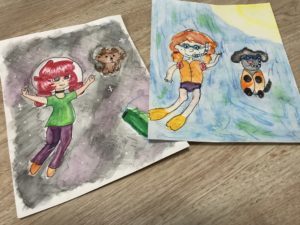
Provide the raw materials.
Both at home and in the classroom I provided the materials that encourage imaginative play. By having the students work together on the illustrations Not only did this promote creativity and abstract thinking, but it also provided opportunities to take on new roles and experiment with teamwork and relationships.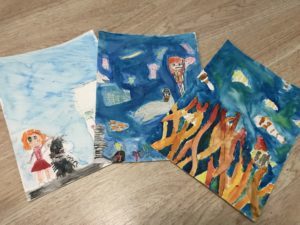
Applaud efforts over outcomes.
While it’s tempting to pile on the praise for a job well done, it’s more important to encourage kids throughout the process to recognize and engage their natural creativity and ability. When a child realizes for himself that he has the ability, potential, and know-how to figure it out, his motivation becomes a much more in-depth pool to draw from. 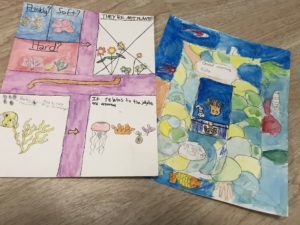
Recognize that one size does not fit all.
Different brains process information in different ways. I am a visual learner, reading directions doesn’t accomplish the same as seeing how to do something. When I checked in with the class on their progress, several had questions about what next step to take. Some asked about color blending. For some students, I needed to verbally explain how to accomplish what they were seeking to achieve. The rest, I had to show them. I even had a video for some to watch as many times as they needed to understand color blending.
So now you might be wondering what happens next? What do I do with the illustrations? Their beautiful drawings will be used as the base idea for the finale illustrations in Little Katie Explores the Coral Reef. I will also display their paintings on my website, and treasure them always!
I hope you enjoyed hearing how I strive to inspire the students I work with. Please, share your thoughts in the comments below for ways to promote creative play both at home and in the classroom.
Before you go, would you please join me in giving this class a big round of applause for their hard work on these magnificent illustrations! 
February 20, 2018
What’s the deal with Read Across America and Dr. Seuss Day?
Have you made a recent trip to Target or Walmart and noticed there are a number of Dr. Seuss related items? Have you noticed that this seems to happen every year around the same time? Why is that? It’s because of the NEA (National Educational Association) Read Across America is an initiative on reading created by the NEA that began in 1997. One part of the project is National Read Across America Day, an observance in the United States held on the school day closest to March 2, the birthday of Dr. Seuss.
The Purpose of Read Across America
Motivating children to read is an essential factor in student achievement and creating lifelong successful readers. Research has shown that children who are motivated and spend more time reading do better in school.
March 2nd is Dr. Seuss Day! What does this mean? It means we look back over the years and reflect on all of his creations from And to Think That I Saw It on Mulberry Street, to Oh, The Places You’ll Go! (Which just happens to be my personal favorite by the Dr. himself) Thinking about all of the works he gave us, and how have they made an impact in the field of Children’s Literature?
I do not believe there is one person among us who would disagree with my saying Theodor Seuss Geisel a.k.a Dr. Seuss was a real genius! However, is it fair for us to say that his books contributed to society? I feel the answer is a big YES!
How many of us have ever read something that inspired us to bigger, and greater things? How many after reading Night by Elie Wiesel were not moved and affected by the account of a Jewish author was sent to Auschwitz at 15-years-old? His story of personal struggle, heartbreak, and passion. Or, Of Mice and Men by John Steinbeck. Giving us new meaning to the American dream, focusing on power and a friendship that will enrage you with jealousy (but in a good way).
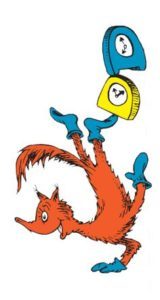 Dr. Seuss showed respect for literature, poetry, and the essence of childhood that many other authors have failed or not come near enough to achieve. Through his works, he shows an endearment to the innocence of children. Showing us through his writings that childhood is the purest, most clever, and most important moment in one’s life.
Dr. Seuss showed respect for literature, poetry, and the essence of childhood that many other authors have failed or not come near enough to achieve. Through his works, he shows an endearment to the innocence of children. Showing us through his writings that childhood is the purest, most clever, and most important moment in one’s life.
Dr. Seuss helped to transform children’s literature into something that can be appreciated by more than children. His whimsical style and rhyming schemes were elements that came to be enjoyed by children, but over time, his works seem to acquire more meaning as the child reader grows up and becomes an adolescent than an adult. The work itself does not change, but the reader does, and looking at the same work over time, new levels of meaning emerge.
His stories not only entertain but teach us invaluable lessons. In the words of Dr. Seuss, “There is no one alive who is Youer than You.” Make the most of what you’ve got. In Yertle the Turtle, we see “feather envy,” and it’s a gentle reminder to be careful what you wish for and appreciate what you’ve got.
As mentioned earlier my favorite Seuss book is Oh, the Places you’ll go! As a child it was a fun read, it made me think about what I would do. But now as an adult, it has much deeper meaning to me. Life is a great balancing act with ups and downs, but it’s up to us to chose what road we will go down.
Dr. Seuss gives such wise advice:
Congratulations!
Today is your day.
You’re off to Great Places!
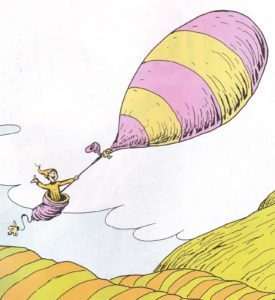
You’re off and away!
You have brains in your head.
You have feet in your shoes.
You can steer yourself any direction you choose.
You’re on your own. And you know what you know. And YOU are the guy who’ll decide where to go.
You’ll look up and down streets. Look’em over with care. About some you will say, “I don’t choose to go there.” With your head full of brains and your shoes full of feet, you’re too smart to go down a not-so-good street
And you may not find any you’ll want to go down. In that case, of course, you’ll head straight out of town. It’s opener there in the wide open air.
Out there things can happen and frequently do to people as brainy and footsy as you.
And when things start to happen, don’t worry. Don’t stew. Just go right along. You’ll start happening too.
Oh! The Places You’ll Go
You’ll be on your way up
You’ll be seeing great sights!
You’ll join the high fliers who soar to high heights.
As the rest of the poem goes on it becomes fascinating. What I love most about this poem is that how he points out, you’ll have times when you’re lonely, or scared about walking down the road you’ve chosen. You will want to turn back, but you’ll go on regardless.
That’s life, that’s all part of its rich tapestry. You’re not alone, and other people are walking their road right beside you. They too have these fears – am I good enough? Will I succeed? Can I do this? But we do, because…
You are off to great places.
Today is your day
Your mountain is waiting
So get on your way!
Dr. Seuss Activities
I have the privilege of spending an entire week with an elementary school to celebrate Read Across America. I will not only read and discuss Dr. Seuss stories with the children, we will also spend time enjoying some book related STEAM (Science, Technology, Engineering, Arts, Math) related activities. Some of the things we have planned can even be enjoyed at home any day of the year!
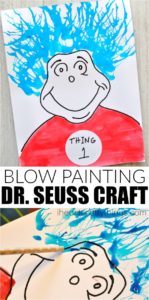
I heart Crafty things showed how to make a blow art painting of Thing 1. This fun Dr. Seuss Craft is a perfect art activity and craft for Read Across America Day on March 2. Kids will have a blast blow painting the crazy blue hair on their Thing 1 or Thing 2. The completed art project would also make a darling display hung up on a bulletin board or classroom display.
The next activity I have planned involves apples. This apple stacking game will not only will teach cause and effect when you drop apples, but how high can you stack an apple? What are the various ways you can build with apples? Just be prepared for them to get bruised up. This game works well after reading Dr. Seuss’ book Ten Apples Up on Top. 
These are just two of the prepared activities I have in store for the first-fifth graders I will be spending the week with. I cannot wait until after week long event is finished to share with all of you how things went. In the meantime, here is a video for you to enjoy of my favorite story by the great Dr. Seuss. What are your favorite works by him? Do you have a reason why you enjoy that book? Please share your comment’s below.
February 14, 2018
Book Giving Day. What is it? How do you participate in it?
February is the month for lovers, or so they say. I certainly do love my ability to collected discounted holiday chocolates! Valentine’s Day, this is the day where we show our loved ones how much we care for them. Of course, I’m sure anyone who is reading this will agree that we should show our family how much we care about them every day, but that’s beside the point. What is my point? My point is LOVE! Love is all around us, the love of books is also in the air! In addition to being a day for lovers, February 14th is also a day for book lovers too! It’s International Book Giving Day! Or known merely as Book Giving Day.
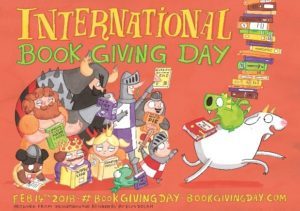
What is International Book Giving Day?
It’s one day a year devoted to instilling a lifelong love of reading in children and providing access to books for children in need, and Book Giving Day calls on volunteers to share their favorite book with a young reader. Although the holiday originated in the UK, book lovers around the world now join in the celebrations every year.
How can you participate?
Sharing is easy! Okay, yes Feb. 14th already passed, that’s okay! What I am about to share with you can be used all year long. How awesome is that!?!
Give a book!
Books make fantastic gifts, ones that can be enjoyed over and over again. They don’t even have to be new. I treasure my used books. There is something special about knowing they have appreciated by many others.
Leave a book in a doctors office.
This is a great way to leave a surprise for a child to discover. Nothing is more boring than waiting to be seen with only magazines to look at. I always find it a pleasant surprise when I look at books out for children to enjoy.
Donate to a Little Free Library.
I happen to live near several conveniently located little free libraries, and two I frequently visit with my son. I donated a copy of my second Lorenzo book, The Adventures of Lorenzo the Bear Journey to Honeysuckle Mountain. Bonus, I signed it and left a message inside for the lucky recipient to find.
These are just a few simple ways to share in Book Giving Day all year long. And when next February 14th rolls around, you will be all set to have a full share in spreading the love of books!
Have you celebrated this holiday before? Leave a comment below and share your experiences with us. Do you have a suggestion for ways to participate? Drop a comment and share your tips, I would love to hear what you have in mind.
Happy Book Giving Day!
January 31, 2018
Get your kids learning STEM from an early age with these easy tips!
 Did you know that there are easy ways to start introducing your little one to STEM even from an early age?
Did you know that there are easy ways to start introducing your little one to STEM even from an early age?
The first few years of your baby’s life are a whirlwind of feedings, a lack of sleep and a steep learning curve. I remember when I was expecting my little boy a long time friend of the family told me that each day might feel like an eternity, but the years will pass by in the blink of an eye. I can attest to these feelings. There are some days where it feels as if the day will NEVER END, and then next thing I know my little guy is a whopping two years old!! As they reach their toddler years, you’re most likely just relieved that they are sleeping through the night, and at least able to eat on their own (even if they are picky about it!).
What many parents don’t realize is that even at this young age, you can start to introduce STEAM (science, technology, engineering, Arts, and math) learning to your toddler. As a children’s STEM/STEAM author, I am always looking for ways to include these fundamentals of everyday play.
 STEM skills are invaluable having quickly become the fastest-growing job sector and likely to stay that way for decades to come.
STEM skills are invaluable having quickly become the fastest-growing job sector and likely to stay that way for decades to come.
Have you considered how often we experience STEM and STEAM in our lives? Science is our natural world sun, the moon, and stars, the oceans, weather, natural disasters, the diversity of nature, animals (large, small, microbial). Think about the fuel that heats our homes and powers transportation; the list is endless. Technology means laptops and smartphones, but it goes back to television, radio, microscopes, telegraph, telescopes, the compass, and even the first wheel. Yes, engineering designs buildings, roads, and bridges, but it also tackles today’s challenges of transportation, global warming and environment-friendly machines, appliances, and systems. We only have to look around to see what improvements to our lives and our homes have been engineered in the last decade alone. We are graced by the beauty of Art in everyday life. The buildings we live in have to be designed by an artist. We encounter mathematics at the grocery store, the bank, on tax forms, in dealing with investments and the family budget. Every other STEAM field depends on mathematics. STEAM is important because it permeates every aspect of our lives.
The question becomes, how can you incorporate STEM and STEAM learning into everyday life naturally? Chances are you are already doing this! In case you are looking for examples of what I mean check out the list below. I have spent countless hours researching ways to incorporate STEM activities into the classrooms I visit, and for everyday life at home and here is what I have found.
Follow these early STEM learning tips and help develop these crucial skills
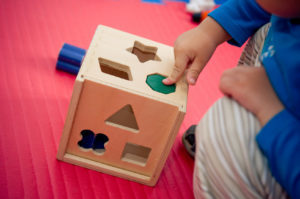
Toddler playing with wooden shape sorter
Practice identifying shapes in everyday things:
Shape sorting toys are fantastic and can provide hours of play (hours in a row are not guaranteed haha). After you’ve taught your child to identify the various shapes, ask them to find them around the house. My little guy loves to find circles; sometimes this includes dumping the cat’s food dishes and bringing them to me. Teach them comparatives and superlatives like big, bigger and biggest.
Don’t show your fear of math:
A widespread joke that you’ll hear adults make (myself included) is that they have terrible math skills. It seems we’re 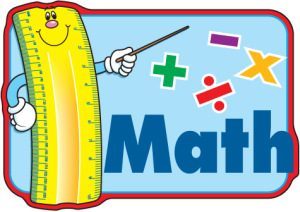 always reaching for our phones to use as a quick calculator rather than doing it in our heads. I’ve heard people say that children will pick up on this and become intimidated by it themselves. Instead, talk through simple arithmetic in front of them so that they already feel confident about this skill when they approach it at school. I happen to be married to a man who is very gifted at math. He’s my very own Rainman. When he works on a math problem, he always verbalizes what he is doing and will work it out by hand on paper or out loud as he gestures in the air. Here’s hoping our little tot is observing this trait of daddy and picks up the same skills as him.
always reaching for our phones to use as a quick calculator rather than doing it in our heads. I’ve heard people say that children will pick up on this and become intimidated by it themselves. Instead, talk through simple arithmetic in front of them so that they already feel confident about this skill when they approach it at school. I happen to be married to a man who is very gifted at math. He’s my very own Rainman. When he works on a math problem, he always verbalizes what he is doing and will work it out by hand on paper or out loud as he gestures in the air. Here’s hoping our little tot is observing this trait of daddy and picks up the same skills as him.
Teach cause and effect:
Show your child simple cause and effect relationships. Turn the lights on and off and explain to them how  when the switch is up, the lights are on, but when flipped down, the lights are off. One of my favorite activites that I also use in classrooms is the apple stacking game. Not only will this teach cause and effect when you drop apples, but how high can you stack an apple? What are the various ways you can build with apples? Just be prepared for them to get bruised up. This game works well after reading Dr. Suess’ book Ten Apples Up on Top.
when the switch is up, the lights are on, but when flipped down, the lights are off. One of my favorite activites that I also use in classrooms is the apple stacking game. Not only will this teach cause and effect when you drop apples, but how high can you stack an apple? What are the various ways you can build with apples? Just be prepared for them to get bruised up. This game works well after reading Dr. Suess’ book Ten Apples Up on Top.
Count, rhyme, and sing:
By counting, rhyming, and singing, you can help your baby to recognize patterns which play an essential role in learning STEM basics. Recognising patterns is the first step in predicting outcomes which is one of the key parts of STEM. Songs like “Old MacDonald” are helpful for teaching patterns because of the repeated phrase (and the animal noises make it lots of fun!).
Get Artsy:
 It’s the process, not the product. We’ve all heard that, right? Especially as it relates to children’s art. For young children, art is about the process of creating, not about how the finished artwork looks. And the younger the child, the more this is true. A toddler’s mind is creative without trying, so let them explore and see what they come up with!
It’s the process, not the product. We’ve all heard that, right? Especially as it relates to children’s art. For young children, art is about the process of creating, not about how the finished artwork looks. And the younger the child, the more this is true. A toddler’s mind is creative without trying, so let them explore and see what they come up with!
What fun STEM and STEAM activites do you like to incorporate into daily life? I would love to hear your thoughts and suggestions so I can use them with my little guy.
Get your kids started early with basic STEM skills with these easy to implement learning tips!
January 17, 2018
Behind the scenes of a podcast with Sarah Meckler-Tate
 I’m sure all of us have either listened to a podcast or at least know of them. In case you are unfamiliar with what a podcast is here’s a quick rundown. It’s a series of spoken, audio episodes, often focused on a particular topic or theme, like cycling or startups. You can subscribe to the show with an app on your phone and listen to episodes whenever you like on your headphones, in the car or through speakers. Simply put, a podcast is talk radio, but on demand.
I’m sure all of us have either listened to a podcast or at least know of them. In case you are unfamiliar with what a podcast is here’s a quick rundown. It’s a series of spoken, audio episodes, often focused on a particular topic or theme, like cycling or startups. You can subscribe to the show with an app on your phone and listen to episodes whenever you like on your headphones, in the car or through speakers. Simply put, a podcast is talk radio, but on demand.
Here’s a question for you, what happens behind the scenes? How does it all come together? How or why does someone get into this gig? To shed some light on these questions Sarah Meckler-Tate shares with us a little bit about her Podcast GMSC Book Review Podcast.
Sarah Meckler-Tate grew up in Montana, the youngest child in a family of readers (her dad is a retired  librarian and her mom tends to read at least a book a day). Sarah got her bachelor’s degree at the University of Montana in Missoula and her Master’s at Pacific Lutheran Theological Seminary in Berkeley and has lived in a variety of places and contexts, having moved 27 times since starting college. She now lives in Elk Grove, CA with her husband, 2 Chihuahuas and 3 bearded dragons. Sarah has been hosting the GSMC Book Review Podcast since it started about a year and a half ago and absolutely loves interviewing authors and hearing their stories. She also loves how it has given her the opportunity to read a lot of books that she might not have read otherwise.
librarian and her mom tends to read at least a book a day). Sarah got her bachelor’s degree at the University of Montana in Missoula and her Master’s at Pacific Lutheran Theological Seminary in Berkeley and has lived in a variety of places and contexts, having moved 27 times since starting college. She now lives in Elk Grove, CA with her husband, 2 Chihuahuas and 3 bearded dragons. Sarah has been hosting the GSMC Book Review Podcast since it started about a year and a half ago and absolutely loves interviewing authors and hearing their stories. She also loves how it has given her the opportunity to read a lot of books that she might not have read otherwise.
I had the privilege of being interviewed on her awesome station, she is totally relaxed and easy to talk with. Our time just flew by before we knew it, we were having to say our goodbyes. If you like to hear our you can visit the link here. CLICK ME!!
Can you tell us a little about your podcast?
The GSMC Book Review Podcast started as a podcast for me to talk about and review books that I had read, whether recently or in the past. It has evolved a bit since the beginning as I am now doing more author interviews and fewer episodes of just me talking about books. My goal with the interviews is to get author’s works out to my listeners. I’m not some intense, hard-hitting journalist who wants to ask the really tough question or uncover some deep, dark secret. I want to talk to the author about their lives and their writing, and I want to present both them and their books in the best light possible so they will gain more 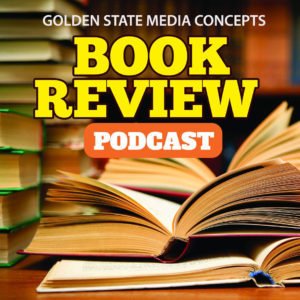 readers.
readers.
Thankfully I haven’t yet read a book that I didn’t like, nor have I interviewed anyone that was awful to talk to, but my hope is that even with difficult books or authors I will be able to highlight what is positive about the book, because of course there is an audience for every genre. Just because I might not find a book to my specific taste doesn’t mean it’s not going to appeal to a wide variety of other people.
What prompted you to start the podcast?
My husband, actually. He is the CEO of the GSMC Podcast Network and when he was developing shows he asked me if I wanted to do a book review podcast because he knows how much I love books. I thought he was crazy as I’d never done anything like this, but once I thought about it I decided it sounded fun. And it has been fun.
I love interviewing authors, learning a little about them, and hearing their stories of writing. I sometimes joke that most people get excited about actors or athletes, but I geek out when it comes to authors. I swear after every interview my husband asks how it went and my answer is always, “it was so much fun! S/he is so interesting!”
I am in awe of the creativity of authors and their ability to put words on paper and create something beautiful and memorable. I’m also in awe of their persistence, because I’ve heard so many of their stories about how difficult it can be to get published. It takes a strong person to go through that kind of rejection and still put something amazing out into the world.
Are there any specific podcast interviews you would like to share with us?
Oh my goodness, all of them! Since that’s probably overkill, I’ll just give you one: My first interview was done in 2 parts and was with one of my best friends, Camille Griep. I have known Cami for over 20 years, so to have her as my first guest was really a blessing because I didn’t have to be worried I was going to screw up with a complete stranger. I could screw up with Cami and she would just laugh along with me. Plus, she has written two really good books, so I was also glad that I could help her promote them in some small way. Here are the links to those episodes:
What is your favorite type of interview to conduct?
Again, all of them! I have had fun with each and every interview I’ve done so far. Seriously, I’m just a dorky book nerd.
Do you have particular genera of books you prefer to host?
I’m really fortunate in that in doing this podcast I have gotten to read genres I don’t always gravitate toward on my own. I read a lot of romance, fantasy, memoirs, Young Adult, and Historical Fiction. I interviewed Curtis C. Chen several months ago about his Kangaroo series, which is Science Fiction. I love watching Science Fiction but don’t usually like reading it because I get bogged down in all of the technical jargon. Kangaroo is so much fun, though, and Curtis makes the science accessible without dumbing it down. I’ve also read more mystery and suspense in the past year than I normally would, which has been great. I haven’t even had to sleep with the light on! The only genre I’m not sure I could do is horror. I’m a total wimp, and I just don’t like the gore and the creepiness and the things that give me nightmares.
What is your editing process like? Do you have help from anyone?
I do the editing myself. Thankfully we have a very user-friendly system in our studio. I know there is more that I could do in terms of editing, and I learn something new each time I do it, but I am by no means a professional sound editor.
My process involves a lot of procrastinating. Not because I don’t like editing, but because editing means I have to listen to myself. Through headphones. I’ve gotten a lot less cringe-y about it, but there are still plenty of moments when I hear something I’ve said and say aloud to the empty studio, “you are SUCH a dork!”
Which writers inspire you?
Shel Silverstein, JK Rowling, Anne Lamott, Roald Dahl, EL Konigsburg. And not to be too cheesy or corny sounding, but all of the authors that I interview. They inspire me with their stories, their determination, their humor, and the fact that they are following their dreams of writing.
What is your favorite ice cream flavor?
It used to be Ben and Jerry’s Dublin Mudslide, but they stopped making it. Pretty much anything chocolate, or chocolate and peanut butter.
It’s been so great talking with you Sarah, one last question before you go. What is your favorite cuisine?
Does chocolate count? I love sushi, my family’s lefse, and I’ve rarely met a soup I didn’t like.
If you would like to learn more about Sarah, or listen to some of her awesome episodes and even discover some new authors be sure to check out the links listed below. If you have any questions or comments for Sarah, please leave a comment below.
January 3, 2018
Looking Back at 2017

Before we get too far into 2018, why not savor our milestone events and take a look back at 2017.
With that goal in mind, my writerly pals and I are sharing our personal moments from last year in the Looking Back at 2017 Blog Hop.
What was my happiest and saddest moment in 2017? What were your highs, and lows? Read my answers below and share my year with me, then be sure and visit the other #GR8Blogs linked at the end of this post for more memorable moments.
I encourage all of you to answer these questions as well so you can reminisce, count your blessings, and remember what you learned along the way!
So, what were my most memorable moments from 2017?
Happiest:
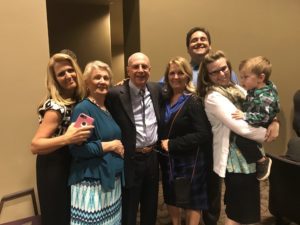
Our family is a very spiritual one. A choice that we made for ourselves is to have God first and foremost in our lives. So, when my husband’s grandfather felt the same and made a personal dedication, we couldn’t have been happier!
Saddest:

In March my dear grandmother suffered a severe stroke. We were not sure if she would make it. Well, she’s a fighter our grandma! She was determined that she was not done living her life and is recovering along nicely. In November, my mother and I flew back down to LA to visit with her and our family.
Accomplishments:
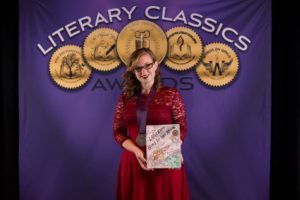
I was totally flabbergasted when I learned in July that one of my books won silver in the 2017 Literary Classics Book Awards Contest! Off we flew to Rapid City South Dakota, to receive my silver award for Little Katie Goes to the Moon and to share in a fantastic weekend of writers workshops, the Great America Book Festival, and hobnobbing with some pretty impressive fellow award-winning authors.
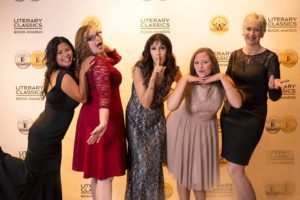
Love:

My amazingly supportive, charming, handsome husband and I celebrated nine years of wedded bliss. Cannot believe this year will be the big 1 0!!
This was the gist of my year. Along the way, I laughed and cried, I learned many things. I was reminded that life could change so quickly and unexpectedly. Things are not always what they seem, and experienced some setbacks with some writing stuff at the end of the year, but that’s ok! 2018 is a new year, filled with fresh possibilities and adventure awaits just around the corner. I wish I could share some of the things I have in the pipes, all in due time. Until then, stick around and see what 2018 has in store!
Thanks for stopping by and sharing my most memorable moments. How was your 2017? If you’re so inclined, share your most memorable moments in the comment section below.
For more look-back moments, visit the #Gr8Blogs below which will be added to.
Julie Gorges: Baby Boomer Bliss
December 13, 2017
Tidbits of History: Guest blog by C.M. Huddleston
Can you believe we only have a few short weeks left before we enter into 2018! There are times I am still amazed by how quickly the year passes. This week I would like to introduce you to a very special guest blogger. Not only is she a multi-award-winning author, but she is also a personal friend of mine. I proudly present to you, C.M. Huddleston
C. M. Huddleston loved history and dreamed of writing a book even as a child. Instead, she became an Army wife, mother, elementary school teacher, archaeologist, and historic preservation consultant, before publishing her first book! In 2017, she published her ninth and tenth volumes, all dealing with her first love, our nation’s past. While four are written for children, her other works are histories for adults on a variety of subjects.
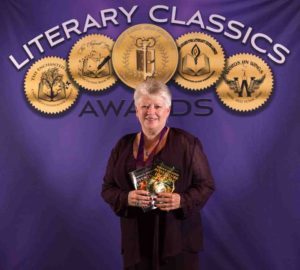
Connie resides in a log cabin in Kentucky, with her husband Charlie and their Australian Shepherd Katie. They all enjoy the quiet of rural Kentucky.
Connie has some very interesting tidbits to share with all of you. If you are anything like me, you will save these for those conversations when you want to share something fun and unexpected. I really appreciated the last one about Brass Monkeys, so read all the way to the end to see what I am referring to. I now turn things over to C.M. Huddleston.
Learning a tidbit about some historical event or person that others might not know can make for an interesting conversation starter or even the subject of a book. Here’s what I mean:
Did you know that James Edward Hanger, a Confederate cavalryman, who lost his leg in the Civil War, started a business which became the world’s largest manufacturer of artificial limbs?
Do you know about the C.S.S. Hunley, the first submarine to sink an enemy ship? Did you know it sank that same night with its entire eight-man crew on board? (Another great tidbit about the Hunley is that author Clive Cussler, who writes thrillers about Dirk Pitt, a diver who often saves the world from the bad guys, paid for most of the recovery and restoration of the Hunley.)
Little Women author, Louisa May Alcott, served as a nurse during the Civil War before she contracted typhoid and had to return home. Her book, Hospital Sketches, is an excellent primary source about Civil War hospitals and nurses.
Winston Churchill, Britain’s Prime Minister during World War II, smoked as many as 16 cigars a day! (He didn’t die of lung cancer.)
But this is one of my favorites: In the heyday of sailing ships, all war ships and many freighters carried iron cannons. Those cannons fired round iron cannon balls. It was necessary to keep a good supply near the cannon. Yet, they needed to prevent them from rolling about the deck. The best storage method devised was a square-based pyramid with one ball on top, resting on four resting on nine, which rested on sixteen. Thus, a supply of 30 cannon balls could be stacked in a small area right next to the cannon. There was only one problem. . .how to prevent the bottom layer from sliding or rolling from under the others. The solution was a metal plate called a Monkey with 16 round indentations. However, if this plate were made of iron, the iron balls would quickly rust to it. The solution to the rusting problem was to make “Brass Monkeys.” Few landlubbers realize how brass contracts much more and much faster than iron when chilled. Consequently, when the temperature dropped too far, the brass indentations would shrink so much that the iron cannonballs would come right off the monkey. Thus, it was quite literally, “Cold enough to freeze the balls off a brass monkey.” (All this time, you thought that was an improper __expression, didn’t you.)
So learn a bit about history to amaze your friends. It can also come in handy when you need to write a story or composition of your own making. Take a historic fact and turn it into a really tall tale! That’s what I do when I write time-travel history for middle-graders and above. I use events from history, often obscure ones, to place my time travelers in the past without having them influence history. For example, Greg, my main character, may one day deliver cigars to Winston Churchill or serve as an ammunition boy on a ship of war or stand on the Charleston shore and watch the C.S.S. Hunley destroy the USS Housatonic and realize the Hunley never returned to shore. He could even be there the day the Hunley was recovered on 8 August 2000.
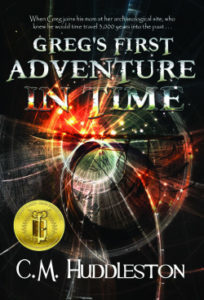
If you would like to learn more about C.M. Huddleston and her multi-award-winning books, be sure to check out Greg’s First Adventure in Time. Archaeology, time travel, and a moose hunt combine to force 12-year-old Greg to face his fears and find his strengths. Greg explores a world that existed more than 3,000 years ago with his new Native American friend Hopelf. While Greg learns about Native American ways of life, how to hunt and fish, and just to survive, he is always searching for a way back home.
Get Social!
November 29, 2017
What does gratitude do for you?
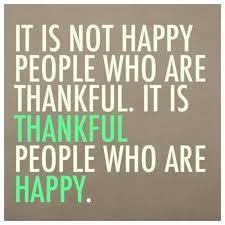
Have you stopped to really think about what the word gratitude means? Gratitude is thankfulness, counting your blessings, noticing the simple pleasures, and acknowledging everything that you receive. It means learning to live your life with full appreciation and being aware on a continuous basis of how much you’ve been given. Gratitude shifts your focus from what your life lacks to the abundance that is already present.
In addition, behavioral and psychological research has shown the surprising life improvements can stem from the practice of gratitude. There is a scripture in the bible that says ‘there is more happiness in giving than there is in receiving.’ Have you found this to be true? Giving makes people happier and more resilient, it strengthens relationships, it improves health, and it reduces stress. Showing a thankful spirit also makes individuals more pleasant to be around.
As imperfect humans, we tend to take for granted the good that is already present in our lives. It’s easier to focus on the negative than the positive. What can help? Can you adjust your perspective? When you focus on what is important and put things in the proper perspective, you can enjoy life more fully.
NOTICE AND APPRECIATE EACH DAY’S GIFTS
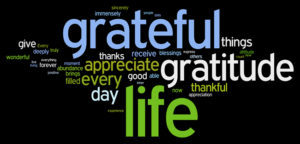
There’s a gratitude exercise that instructs that you should imagine losing some of the things that you take for granted, such as your home, your ability to see or hear, or anything that currently gives you comfort. Then imagine getting each of these things back, one by one, and consider how grateful you would be for each and every one. In addition, you need to start finding joy in the small things instead of holding out for big achievements—such as getting the promotion, having a comfortable nest egg saved up, and so on–before allowing yourself to feel gratitude and joy.
Life is filled with uncertainty, things will not always go your way. The difficulty will arise in one form or another. Every challenge we face carries within it the seeds of an equal or greater benefit. In the face of adversity ask yourself: “What’s good about this?”, “What can I learn from this?”, and “How can I benefit from this?”
THERE ARE MANY WAYS TO PRACTICE GRATITUDE
A common method to develop the practice of gratitude is to keep a gratitude journal, a concept that was made famous by Sarah Ban Breathnach’s book “Simple Abundance Journal of Gratitude”. This exercise basically consists of writing down every day a list of three to ten things for which you are grateful; you can do this first thing in the morning or before going to bed at night. You can write a letter to someone who has really impacted your life but you haven’t properly thanked them (added bonus would be to mail it, who doesn’t enjoy getting a handwritten letter in the mail).
CONCLUSION
Once you become oriented toward looking for things to be grateful for, you will find that you begin to appreciate simple pleasures and things that you previously took for granted. Gratitude should not be just a reaction to getting what you want, but an all-the-time gratitude, the kind where you notice the little things and where you constantly look for the good even in unpleasant situations. Today ends the 30 days of thanks, but it doesn’t have to stop here. Keep giving thanks and showing gratitude for the everyday things in life. Make this a practice 365 days a year, and I am sure you will find yourself enjoying the things around you more.



